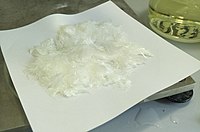
Photo from wikipedia
Hexahydro‐1,3,5‐trinitro‐1,3,5‐triazine (RDX) is a high explosive released to the environment as a result of weapons manufacturing and testing worldwide. At Los Alamos National Laboratory, the Technical Area (TA) 16 260… Click to show full abstract
Hexahydro‐1,3,5‐trinitro‐1,3,5‐triazine (RDX) is a high explosive released to the environment as a result of weapons manufacturing and testing worldwide. At Los Alamos National Laboratory, the Technical Area (TA) 16 260 Outfall discharged high‐explosives‐bearing water from a high‐explosives‐machining facility to Cañon de Valle during 1951 through 1996. These discharges served as a primary source of high‐explosives and inorganic‐element contamination in the area. Data indicate that springs, surface water, alluvial groundwater, and perched‐intermediate groundwater contain explosive compounds, including RDX (hexahydro‐1,3,5‐trinitro‐1,3,5‐triazine); HMX (octahydro‐1,3,5,7‐tetranitro‐1,3,5,7‐tetrazocine); and TNT (2,4,6‐trinitrotoluene). RDX has been detected in the regional aquifer in several wells, and a corrective measures evaluation is planned to identify remedial alternatives to protect the regional aquifer. Perched‐intermediate groundwater at Technical Area 16 is present at depths from 650 ft to 1200 ft bgs. In this study, we examined the microbial diversity in a monitoring well completed in perched‐intermediate groundwater contaminated by RDX, and examined the response of the microbial population to biostimulation under varying geochemical conditions. Results show that the groundwater microbiome was dominated by Actinobacteria and Proteobacteria. A total of 1,605 operational taxonomic units (OTUs) in 96 bacterial genera were identified. Rhodococcus was the most abundant genus (30.6%) and a total of 46 OTUs were annotated as Rhodococcus. One OTU comprising 25.2% of total sequences was closely related to a RDX ‐degrading strain R. erythropolis HS4. A less abundant OTU from the Pseudomonas family closely related to RDX‐degrading strain P. putida II‐B was also present. Biostimulation significantly enriched Proteobacteria but decreased/eliminated the population of Actinobacteria. Consistent with RDX degradation, the OTU closely related to the RDX‐degrading P. putida strain II‐B was specifically enriched in the RDX‐degrading samples. Analysis of the accumulation of RDX‐degradation products reveals that during active RDX degradation, there is a transient increase in the concentration of the degradation products MNX, DNX, TNX, and NDAB. The accumulation of these degradation products suggests that RDX is degraded via sequential reduction of the nitro functional groups followed by abiotic ring‐cleavage. The results suggest that strict anaerobic conditions are needed to stimulate RDX degradation under the TA‐16 site‐specific conditions.
Journal Title: MicrobiologyOpen
Year Published: 2017
Link to full text (if available)
Share on Social Media: Sign Up to like & get
recommendations!